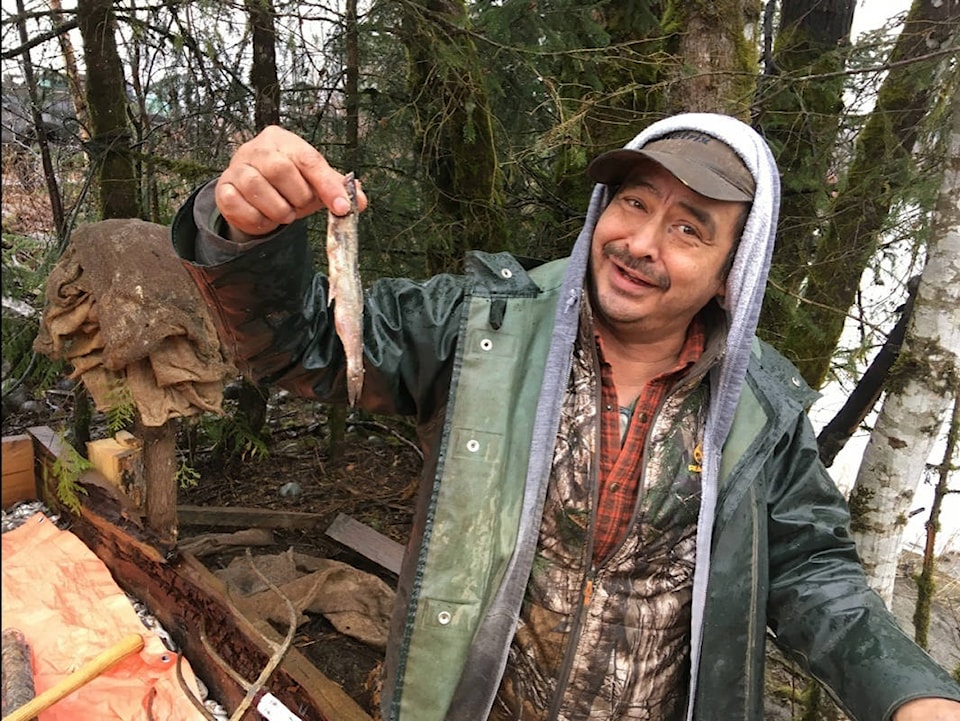There’s that familiar odour in the air once again: the unmistakeable smell of ooligan. For the second year in a row thousands of pounds of ooligan have been trucked in from the Nass River and cookers are busy once again processing all these fish at their camp near Tatsquan Creek on the Bella Coola.
It’s a ritual that is sorely missed: the last healthy ooligan run here happened more than 20 years ago. Since then, an entire generation of Nuxalk people have missed out on its many benefits, which are both physical and cultural.
Ooligan, or “sputc” as they are known in Nuxalk, pack a powerful punch for a tiny fish. A McGill University study on the Nutritional Qualities of Ooligan Grease from 1996, which included samples from the Bella Coola, concluded that the ooligan grease is more than 98 percent fat and is rich in omega-3 fatty acids and Vitamin A, E and K. It also contains significant amounts of calcium, zinc and iron, all of which are important to human diets.
The study also detailed how ooligan grease was used as a medicine for various ailments, such as skin rashes, intestinal disorders, tuberculosis, and flu. Bert Mack, one of the few of the younger generation who are passionate about making grease, concurs.
“I see a lot more sickness among our people today,” Mack said. “25 years ago when everyone had grease there was a lot less illness in our community. It really is a medicine.”
Elders at the camp talked of how they used to take a spoonful every night at bedtime from their dedicated parents; a cure for all that ails you.
“Every night we had a spoonful,” said Frank Tallio Sr. “It’s just the way it was.”
“It keeps you healthy and at the same time rids your body of what it doesn’t need,” Mack explained. “When I eat grease, I feel better. It’s that simple.”
Down on the riverbank a fire is dug into the earth and a large wooden box sits on top, the water slowly bubbling the ooligan all day long to draw the grease from their bodies.
Everyday a new batch starts cooking in the early morning and runs until late evening, when the grease is finally ready to skim from the surface and the bodies of the little fish are mashed to a paste.
Cooking is specific and calculated. How it’s prepared affects everything from the consistency of the grease to how it tastes, and everyone cooks it slightly differently. However, there are general rules that must be followed to enjoy a good product at the end.
“You can’t have it at a rolling boil and you can’t have it too cold,” explained Tallio. “Otherwise the grease will go back into the fish.”
Careful attention must also be paid to how long and how hot the fish are cooked, as it needs to be boiled slowly to render the grease effectively.
“I’ve seen people lose an entire batch because it wasn’t processed properly,” said Mack. “That’s something you don’t want to happen: it’s a lot of work.”
Ooligan was a mainstay of the Nuxalk diet, and traditional Indigenous diets have been proven to reduce incidence of diabetes, heart disease, and stroke. Dr. Jay Wortman, a Metis doctor based in Vancouver, said his experiment with a traditional Indigenous diet was remarkable.
After being diagnosed with Type 2 diabetes, Wortman made a radical shift in his eating habits and opted for traditional coastal foods, such as salmon and ooligan, over highly-processed ones.
“All my blood markers went back to normal. I lost weight at about the rate of about a pound a day for a month,” he said.
The Nuxalk Food and Nutrition Program noted that the Nuxalk traditional food system is a healthy one, and that protecting it not only benefits the health of the general population but also the overall coastal environment.
This connection between traditional food and the environmental health of the coastal ecosystem has been part of Nuxalk scientist Megan Moody’s research over the past decade.
Moody did her master’s thesis on ooligan, and she found strong links between climate change and overfishing through bycatch as major contributions to the decline in Bella Coola’s ooligans.
“Ooligan bycatch was a huge problem for the shrimp trawlers in Queen Charlotte Sound,” explains Moody. “There are estimates that between 90 and 150 tonnes of ooligan was being caught as bycatch by the trawling industry.”
Alterations have since been made to help the trawling industry avoid the enormous bycatch, but the Bella Coola run hasn’t yet recovered. There have been a few schools sighted over the years, but nothing that can compare to the traditional runs.
“We have seen some eagles fishing along the edge so there may be a few in the river right now,” Mack said. “But it’s nothing like it used to be. The river used to be so thick with ooligan we could scoop them out with our hands.”
Mack recalled how, as a child, he and his friends would run home with bucketfuls of ooligans and dump them in the bathtub to keep them alive.
“My mom would scoop them out and fry them up,” he laughs. “‘We’re eating them!’ she’d say.”
The grease will be shared with the community and so far it’s been profitable cooking. About 18 gallons of grease was strained from the first cooking of approximately 600 lbs, and there is plenty more waiting in the stinkbox.
Marlene King, who wrote a grant through the Copper Women’s Society to support the project, said costs will most likely exceed $30,000 this year.
“Last year it cost about $46,000 and was mostly funded through grants, the Nation, and the College,” said King. “So far we have received six tonnes of ooligans and we plan to distribute one pint of grease per household to the Nation.”
